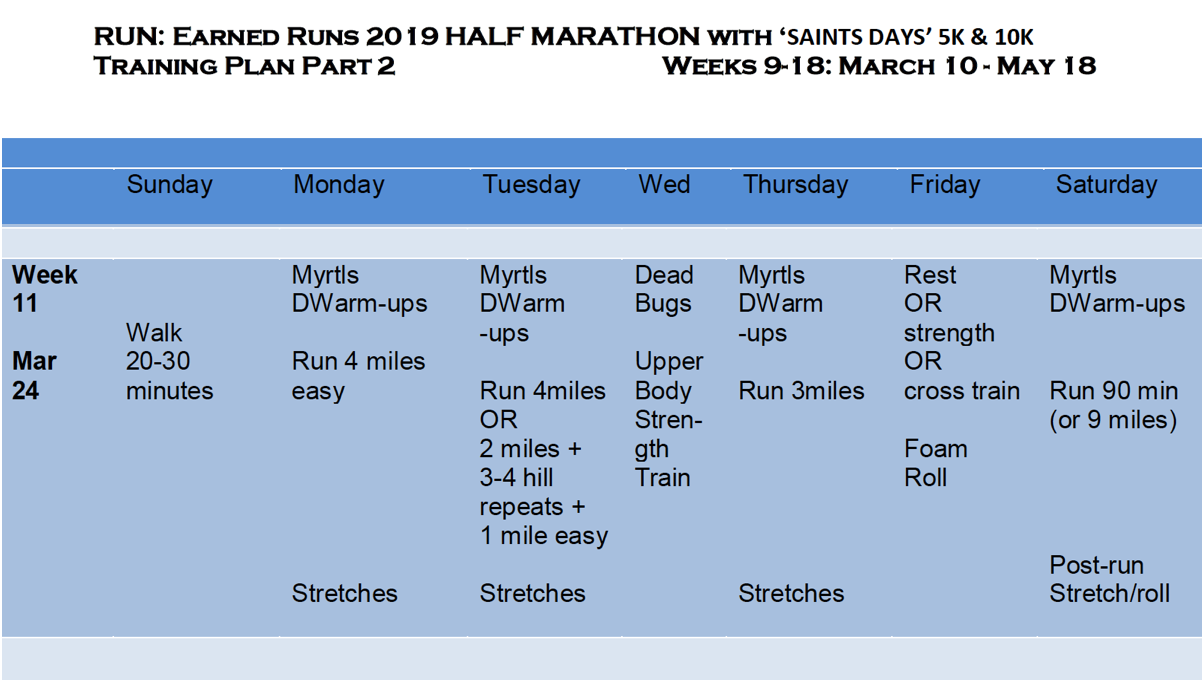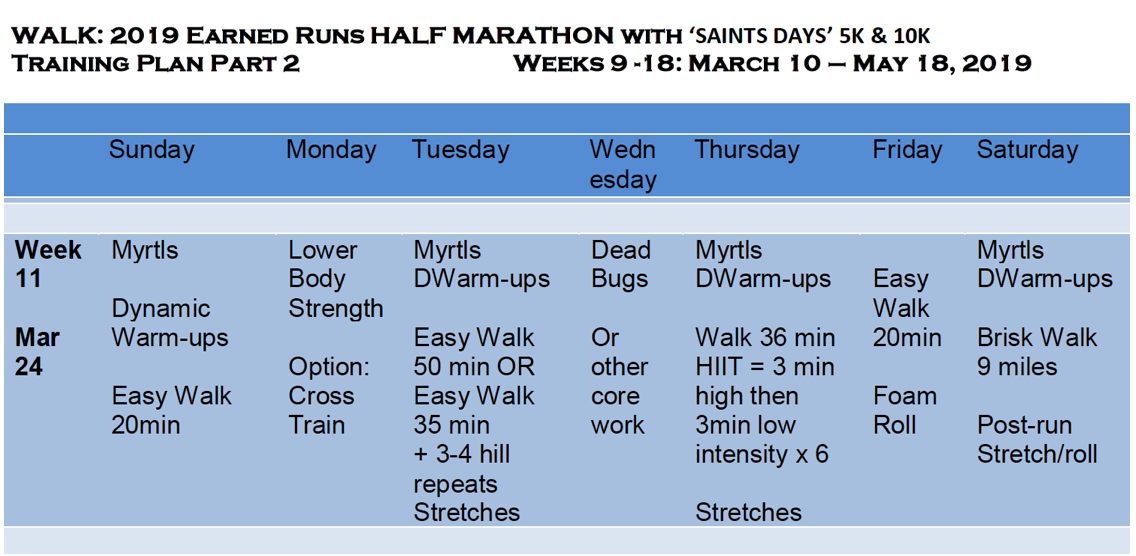BLOG
|
|
WEEK 11 HALF MARATHON 2019 TRAINING PLAN STARTS You should be settling into a rhythm by now, but you’ll notice a few changes on the horizon.
The WALK schedule includes 1 short ‘easy’ walk + 2 longer ‘easy’ walks + 1 high intensity interval training (HIIT) that’s been bumped to a duration of 36 minutes this week + 1 long ‘brisk’ walk. On the next 2 Tuesdays there’s still an option of a hill repeat workout, but it disappears in April, replaced by walks of decreasing duration as the long weekend walks increase to distances above 10 miles. After hitting 13 miles on April 21, the taper will begin. IMPORTANT WALKER NOTE: If you are planning to cover the 13.1-mile half marathon distance just to finish in a custom solo personal race, you can treat April 21 as your official event day and be done with training! If you’re registered for an organized event later in April or May, you may wish to continue to build mileage then follow the taper. The Earned Runs plan adapts a Hal Higdon program that stops at 10 miles /12 weeks. The ER plan is taking competition-minded walkers out to the actual distance. To gain confidence from surviving the full distance, but at a slower pace. In training you’ll be walking more easily with breaks and stops as needed. On race day, in the company of other competitors, ER thinks you’ll push yourself to a higher intensity, and for safety reasons to possibly avoid injury, is offering the opportunity to train the actual distance. However, this strategy is not based on the advice of an expert or another plan; information could not be found that supports or refutes it. The RUN schedule includes 1 recovery walk + 3 shorter distance runs + 1 long run, each week. The types of shorter distance runs have not been specified up to this point, although 1 hill repeats session has been offered as an option on Tuesdays. In week 13 there will be an option of a tempo run on Thursdays. However, runners can individualize one or both sessions now that all work is focused on the half marathon. Remember, this plan is for beginners or those getting back into running races who did not have one available to them for this distance. Advanced runners who wish to increase their speed to a faster pace and finish with an improved time will have scanned this plan and likely realized it was not going to help with that. They will have used a plan provided by event organizers if formally registered for a race, or found one online that promised to prepare runners for their “best finish time ever.” Beginners can choose to run hill repeats on Tuesday or run easy steady continuous speed run that day. They have 3 options (see below) for running the shorter distance session on Thursday. #1 is for runners who only wish to “finish” the 13.1K distance and are not concerned with time. #2 is for those who wish to finish strong but aren’t focused on gaining speed. #3 is for runners who wish to push their limits a bit more, and test themselves in the upcoming event.
Jenny Hadfield offers 4 tempo runs for runners who are new to them in an article for Runnersworld.com, “Four Tempo Workouts for Runners”. Included are warm-ups and cool-downs, which are a must! You are roughly running 2-4 miles, because the exact distance will vary by running pace. With increased running intensity in certain segments, the swap with a 3-mile run would be fine, and suitable for the Thursday 3 mile run, especially if you're not running hill repeats. If you are new to racing, the “high-five” tempo workout listed first might help you deal with one aspect of competition, the speed-ups and slow-downs normally experienced in a race if you’re not a leader at the head of the pack. For example, you occasionally might wish to speed up and pass a group that has slowed down in front of you, then dial it back a bit after the harder work. Or tackle a long, low hill that requires more effort, after which you take a little breather by easing up. When you are training by yourself or with friends you or they control the pace. In a competition, you and your running partners will not always be in control as others surge or fall off their pace around you, which will prevent movement in a straight-line direction If not ready for it mentally and physically, it could throw off your race plan. Have fun experimenting with these shorter runs soon. There’s enough time now, before the race, to try the negative split, the tempo run, or both, and revert to the old comfortable routine if the change-up doesn’t work for you. RUNNERS and WALKERS, recognize the progress you've made and be proud. RUN & MOVE HAPPY! http://www.runnersworld.com/tag/tempo-run http://www.runnersworld.com/ask-coach-jenny/four-tempo-workouts-for-runners
0 Comments
Your comment will be posted after it is approved.
Leave a Reply. |
BRIDGE TO PHYSICAL SELF
Running, walking, and fitness activities enable us to experience our physical selves in a world mostly accessed through use of fingers on a mobile device. AuthorEARNED RUNS is edited and authored by me, runner and founder. In 1978 I began participating in 10K road races before 5Ks were common. I've been a dietitian, practiced and taught clinical pathology, and been involved with research that utilized pathology. I am fascinated with understanding the origins of disease as well as health and longevity. Archives
November 2023
CategoriesNew! Search Box
Earned Runs is now searchable! Check it out...
|




 RSS Feed
RSS Feed